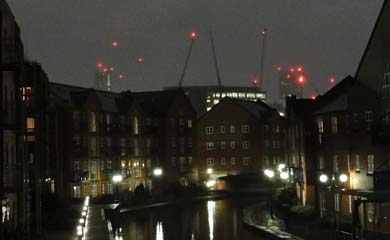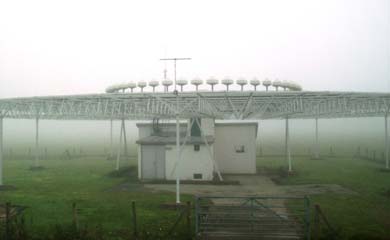The need for lighting
Tall structures can present a risk for aircraft. This includes building developments, and collision risk is one of the many aviation considerations that developers need to consider at the planning stage.
Collision risk is generally managed by doing two things, namely limiting the height of a building in critical areas and/or requiring aviation lighting to be fitted to the building.

Figure 1: Aviation lighting on buildings and construction cranes – UK
Types of lighting
There are many kinds of lighting that can be utilised for aviation safety purposes. Variables include intensity, colour and whether the light is steady or flashing.
Steady red lights are a common choice for buildings and cranes in many parts of the world. However, flashing white lights, for example, are also a possible option.
The rules for lighting
Lighting requirements are usually defined by an individual country’s civil aviation authority. Specific requirements can also be set by military authorities. Individual stakeholders such as large airports may have their own preferences in terms of lighting that they would like to see.
For the UK, aviation lighting requirements are defined within the UK Civil Aviation Authority’s Civil Aviation Publication 168: Licensing of Aerodromes. Guidance on the subject is also available from the International Civil Aviation Organisation and the European Union Aviation Safety Agency.
Developments that require aviation lighting
The maximum height – or more accurately, the maximum altitude – that a building can be in the vicinity of an airport is typically defined by Obstacle Limitation Surfaces. A full discussion of Obstacle Limitation Surfaces is not presented here, suffice it to say that maximum altitudes for fixed obstructions are defined around major airports by considering imaginary surfaces surrounding them. Where a building infringes such a surface, aviation lighting is almost guaranteed to be a requirement (if the risk can be tolerated at all). This means that even modest buildings of one or two storeys can, in principle, require aviation lighting for safety reasons.
In many countries, there is a defined height from ground level above which aviation lighting is mandatory, regardless of where the nearest airport is. In the UK, for example, anything that is 150 metres or more above ground requires mandatory lighting.
Other factors that can determine the lighting requirement in practice include whether surrounding buildings in the area are fitted with lighting, requests from local airports/heliports and whether the building is likely to be illuminated by other sources.
Downsides of Lighting
Aviation lighting can be unpopular with surrounding residents on the grounds of amenity and light pollution. This can be of particular concern for intermediate lighting i.e. lights that are fitted on the sides of tall buildings, which can be particularly unpopular with residents of neighbouring tall buildings.
What to do
When proposing a new development, it is important to understand the surrounding environment in an aviation context. If the development is within 20 km of an airport, detailed consideration of physical safeguarding (Obstacle Limitation Surfaces) is recommended, which may highlight a lighting requirement. The location of nearby local airfields and heliports should be considered.
If the development’s maximum height exceeds the mandatory lighting requirement, an aviation lighting scheme must be designed.
If lighting is required, the first step is to understand the published rules based on the development scale and location, usually published by the appropriate Civil Aviation Authority. Keep in mind that there may be multiple options for a lighting scheme, all of which could satisfy the relevant requirements. Collaboration with the most significant stakeholders is advisable, which will often be the nearest major airport.
Once the rules are understood, a lighting scheme should be designed based on the applicable requirements and pragmatic considerations including the surrounding environment.
The resulting scheme may require sign-off from a particular stakeholder, depending on the trigger for the lighting requirement.
Pager Power
Pager Power has been conducting aviation assessments since the early 2000s. The company has developed good relationships with aviation stakeholders in many countries and assisted in overcoming aviation issues for numerous projects (see our projects page for more information). If you wish to discuss any of your existing or upcoming projects, please do not hesitate to contact the team.



